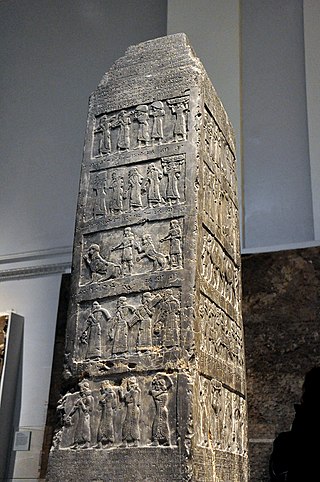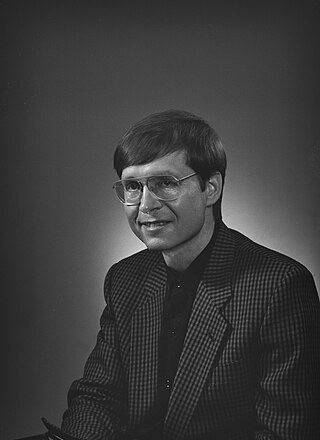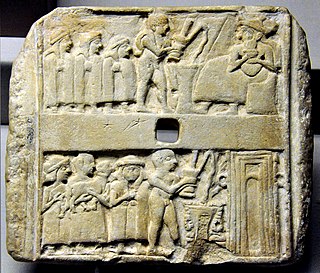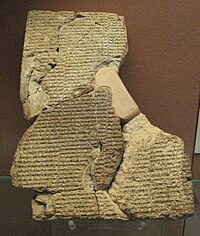
Gilgamesh was a hero in ancient Mesopotamian mythology and the protagonist of the Epic of Gilgamesh, an epic poem written in Akkadian during the late 2nd millennium BC. He was possibly a historical king of the Sumerian city-state of Uruk, who was posthumously deified. His rule probably would have taken place sometime in the beginning of the Early Dynastic Period, c. 2900–2350 BC, though he became a major figure in Sumerian legend during the Third Dynasty of Ur.

Hammurabi, also spelled Hammurapi, was the sixth Amorite king of the Old Babylonian Empire, reigning from c. 1792 to c. 1750 BC. He was preceded by his father, Sin-Muballit, who abdicated due to failing health. During his reign, he conquered the city-states of Larsa, Eshnunna, and Mari. He ousted Ishme-Dagan I, the king of Assyria, and forced his son Mut-Ashkur to pay tribute, bringing almost all of Mesopotamia under Babylonian rule.

Noah appears as the last of the Antediluvian patriarchs in the traditions of Abrahamic religions. His story appears in the Hebrew Bible, the Quran and Baha'i writings, and extracanonically.

Mesopotamian religion refers to the religious beliefs and practices of the civilizations of ancient Mesopotamia, particularly Sumer, Akkad, Assyria and Babylonia between circa 6000 BC and 400 AD. The religious development of Mesopotamia and Mesopotamian culture in general, especially in the south, were not particularly influenced by the movements of the various peoples into and throughout the area. Rather, Mesopotamian religion was a consistent and coherent tradition, which adapted to the internal needs of its adherents over millennia of development.

In Mesopotamian religion, Tiamat is the primordial sea, mating with Abzû (Apsu), the groundwater, to produce the gods in the Babylonian epic Enûma Elish, which translates as "when on high." She is referred to as a woman, and has—at various points in the epic—a number of anthropomorphic features and theriomorphic features.

The Black Obelisk of Shalmaneser III is a black limestone Neo-Assyrian sculpture with many scenes in bas-relief and inscriptions. It comes from Nimrud, in northern Iraq, and commemorates the deeds of King Shalmaneser III. It is on display at the British Museum in London, and several other museums have cast replicas.

Nabu is the Babylonian patron god of literacy, the rational arts, scribes, and wisdom. He is associated with the classical planet Mercury in Babylonian astronomy.

The Two Babylons, subtitled Romanism and its Origins, is a book that started out as a religious pamphlet published in 1853 by the Presbyterian Free Church of Scotland theologian Alexander Hislop (1807–65).
Ancient Semitic religion encompasses the polytheistic religions of the Semitic peoples from the ancient Near East and Northeast Africa. Since the term Semitic represents a rough category when referring to cultures, as opposed to languages, the definitive bounds of the term "ancient Semitic religion" are only approximate but exclude the religions of "non-Semitic" speakers of the region such as Egyptians, Elamites, Hittites, Hurrians, Mitanni, Urartians, Luwians, Minoans, Greeks, Phrygians, Lydians, Persians, Medes, Philistines and Parthians.
The religions of the ancient Near East were mostly polytheistic, with some examples of monolatry. Some scholars believe that the similarities between these religions indicate that the religions are related, a belief known as patternism.

Canaanite religion was a group of ancient Semitic religions practiced by the Canaanites living in the ancient Levant from at least the early Bronze Age to the first centuries CE. Canaanite religion was polytheistic and in some cases monolatristic. It was influenced by neighboring cultures, particularly ancient Egyptian and Mesopotamian religious practices. The pantheon was headed by the god El and his consort Asherah, with other significant deities including Baal, Anat, Astarte, and Mot.

Babylonian religion is the religious practice of Babylonia. Babylonia's mythology was largely influenced by its Sumerian counterparts and was written on clay tablets inscribed with the cuneiform script derived from Sumerian cuneiform. The myths were usually either written in Sumerian or Akkadian. Some Babylonian texts were translations into Akkadian from Sumerian of earlier texts, but the names of some deities were changed.

Simo Kaarlo Antero Parpola is a Finnish Assyriologist specializing in the Neo-Assyrian Empire and Professor emeritus of Assyriology at the University of Helsinki.
Tikva Simone Frymer-Kensky was a professor at the University of Chicago Divinity School. She received her MA and PhD from Yale University. She had previously served on the faculties of Wayne State University, the Jewish Theological Seminary of America, Yale University, Ben Gurion University, and the Reconstructionist Rabbinical College, where she served as director of Biblical studies.

Friedrich Delitzsch was a German Assyriologist. He was the son of Lutheran theologian Franz Delitzsch (1813–1890).
"The Bible's Buried Secrets" is a Nova program that first aired on PBS, on November 18, 2008. According to the program's official website: "The film presents the latest archaeological scholarship from the Holy Land to explore the beginnings of modern religion and the origins of the Hebrew Bible, also known as the Old Testament. This archaeological detective story tackles some of the biggest questions in biblical studies: Where did the ancient Israelites come from? Who wrote the Bible, when, and why? How did the worship of one God—the foundation of modern Judaism, Christianity, and Islam—emerge?"

Sumerian religion was the religion practiced by the people of Sumer, the first literate civilization found in recorded history and based in ancient Mesopotamia, and what is modern day Iraq. The Sumerians widely regarded their divinities as responsible for all matters pertaining to the natural and social orders of their society.

Chronicle P, known as Chronicle 22 in Grayson’s Assyrian and Babylonian Chronicles and Mesopotamian Chronicle 45: "Chronicle of the Kassite Kings" in Glassner's Mesopotamian Chronicles is named for T. G. Pinches, the first editor of the text. It is a chronicle of the second half of the second millennium BC or the Kassite period, written by a first millennium BC Babylonian scribe.

Babylonian Religion and Mythology is a scholarly book written in 1899 by the English archaeologist and Assyriologist L. W. King (1869-1919). This book provides an in-depth analysis of the religious system of ancient Babylon, researching its intricate connection with the mythology that shaped the Babylonians' understanding of their world. It examines the psychism and thought processes of the Babylonian people, covering the main beliefs that were central to their lives and culture. The book aims to explain the foundational myths and religious practices that played a significant role in Babylonian civilization.














